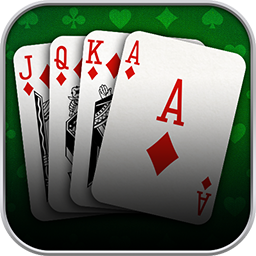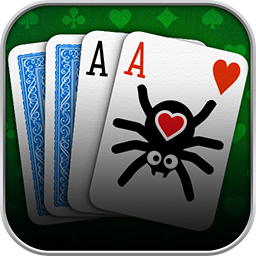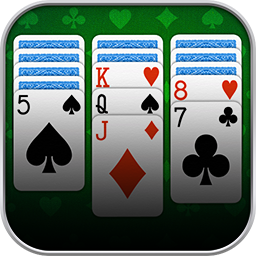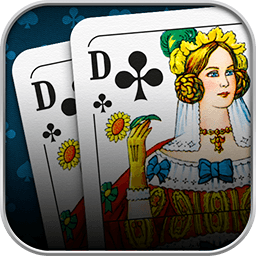You do not have to know everything. Get your Solitaire info quickly with this handy alphabetical overview! We collected the most important Solitaire terms in this glossary. Check our Solitaire manual for more details.
Custom rules:
When creating a table at the Solitaire Palace, you get to set up the game as you please. You can choose from the rules Turn Three, Joker, Undo Off, Max 3 Cycles, Fast, Relaxed, Easy, Double, Easthaven, and Training.
Deck:
This term refers to a complete set of playing cards. In Klondike Solitaire, this means 52 traditionally French-suited playing cards, with each of the 13 ranks occurring once per suit.
Double (Custom Rule):
Play with double the cards – two sets of 52 cards.
Easthaven (Custom Rule):
This custom rule switches the game to Easthaven, a relative of Klondike Solitaire. The modifications concern the game’s setup as well as the rules in the tableau and stock. Find out all the details here.
Easy (Custom Rule):
When activating this custom rule, you can place any card on empty tableau piles. In standard Klondike Solitaire, only Kings are allowed there.
Fast (Custom Rule):
This custom rule shortens the standard time for solving the game in one round.
Foundation:
This area of the table holds the four foundation piles. They are empty at the beginning of the round. The game’s objective is to place all cards here, separated by suits. To do that, you must sort the cards into uninterrupted sequences: In the foundation, the Ace is on the bottom, then 2, 3, 4, 5, 6, 7, 8, 9, 10, Jack, Queen, and King on the top.
Foundation Pile:
These are the four piles of cards forming the foundation at the top right of the playing field. They are empty at the beginning of each round.
Joker (Custom Rule):
This rule gives you some support. Each player receives three Jokers: An additional button showing the Joker symbol appears on the playing field. When using a Joker, you select a foundation pile that will automatically receive a matching card. This card will be moved there from any position in the stock, tableau, or waste. When solving a round, unused Jokers add bonus points to your total score.
Klondike:
This is the default game at the Solitaire Palace. You can switch to the variant Easthaven using custom rules. If you prefer Spider and Scorpion Solitaire, check out the Spider Palace.
Max 3 Cycles (Custom Rule):
When using this custom rule, you can flip through the stock three times at most. Thus, you need to play more strategically: If you cannot place all the stock cards in the tableau or foundation within the three stock cycles, there is no more chance to solve the game. Of course, you can carry on and collect points until you run out of moves.
Multiplayer Mode:
At the Solitaire Palace, there is no need for solo playing unless you prefer it. In multiplayer mode, you compete with your fellow players with identical setup in the tableau and stock. Since each move is scored, solving the game becomes comparable. The number of moves it takes you to solve the game and whether you solve it fastest both affect the scoring.
Patience:
Solitaire is a type of patience game. The word is derived from the French language and might point to the game’s probable origin as an exercise in patience. Patience games are commonly referred to as solitaire games. Both are umbrella terms for many related but different games. At the Solitaire Palace, you can play Klondike and Easthaven.
Points:
Each move in a round of Solitaire scores either positive or negative points. How efficiently you solve your game affects the result. You will gain most points by successfully solving a game, of course! Based on that scoring, different approaches to solving the same setup become comparable.
Rank:
There are 13 ranks in Solitaire. Their descending order goes King, Queen, Jack, 10, 9, 8, 7, 6, 5, 4, 3, 2, and Ace. You must follow this order when completing the sequences in the tableau. But when placing cards in the foundation, you need to follow the ascending order.
Relaxed (Custom Rule):
Here, all cards of the tableau are revealed from the beginning. This way, the game is easier and more tranquil: You can see where crucial cards are and thus free them strategically.
Round:
At a table in the Solitaire Palace, you can play several rounds. Each round’s scores are summed up to determine the table’s winner via the total scores. A round ends either after one player placed all cards onto the foundation piles, when no player can make any more moves, when all players give up, or when the time is up.
Scoring:
See Points.
Sequence:
A sequence is a complete and correctly sorted group of cards, with each rank occurring once. In Solitaire, the sequences are sorted differently in the tableau and the foundation: The base card must be King in the tableau, and the rest follows in descending order of ranks. The base card must be Ace instead in the foundation, with the rest following in ascending order of ranks.
Solitaire:
See Patience.
Stock:
At the beginning of a round of Klondike Solitaire, 24 cards remain face-down. They become the stock in the top left of the playing field. During play, you can draw one card at a time from the stock to the waste to reveal it. Now, you decide whether you place it on a foundation or tableau pile, or leave it where it is. Once the stock is empty, the waste becomes the face-down stock again. The custom rules Easthaven, Max 3 Cycles, and Turn Three modify the stock’s workings.
Suit:
Klondike and Easthaven traditionally use French-suited playing cards. Thus, the suits are Clubs, Spades, Hearts, and Diamonds.
Table:
At the Solitaire Palace, you can play Klondike Solitaire or Easthaven at different tables. They can vary in the number of players, the number of rounds, player requirements, and selected custom rules. Join the table you like best! A table ends when a predefined number of rounds is finished.
Tableau:
That is the largest area of the playing field. At the beginning of each round, 28 cards are dealt to the tableau in seven piles. The first one contains one card, the following six piles hold one more card than each previous pile. Then, each top card is revealed. Here, you can add cards from the waste and move cards from pile to pile to sort the cards gradually. You can also move cards from here to the foundation.
Tableau Pile:
These are the seven piles of cards forming the tableau in the center of the playing field. You can move cards here by combining them black-red or red-black. You can only move a card from one pile to another if the moving card is one rank lower than the target card. The same goes for moving several cards at once – no gaps allowed. The correct order of a tableau sequence is King at the bottom, Queen, Jack, 10, 9, 8, 7, 6, 5, 4, 3, 2, and Ace on top. If a tableau pile is empty, you can only place Kings there. Revealed tableau cards can be moved to the foundation individually.
Training (Custom Rule):
A table with this rule does not affect the league. That means no points, Chips, or ratings will change. But you keep collecting experience points.
Turn Three (Custom Rule):
Three cards instead of one card will be taken from the stock and placed in the waste in one go. As you can still only use the top card of the waste, the game becomes more challenging that way.
Undo Off (Custom Rule):
Disable the undo feature with this custom rule. You now have to see your decisions through to the end of the round. That makes the game a bit more challenging.
Waste:
This is the initially empty panel next to the stock. When you draw a card from the stock, it will be revealed here. Now you can place it in the tableau or the foundation or draw the next card. Once the stock is empty, the waste becomes the face-down stock again.










